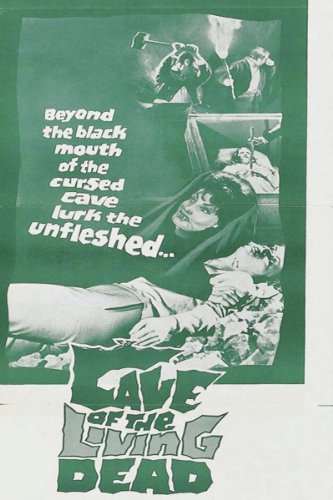
Synopsis: Inspector Frank Dorin (Adrian Hoven) is widely regarded as the best detective in the country, and only hours after starting his vacation he’s called back for an urgent case. He is dispatched by the Chief Constable to a small German village to investigate a mysterious series of deaths: six young women have died, ostensibly of heart failure, though they all seemed to be in perfect health.
The chief constable is worried that if the press finds out federal investigators are looking into the deaths, it’ll turn into a media circus, so he warns Dorin that once he’s on the case he should ask for no additional resources. He gives Dorin a couple of bits of information that might be of help: first, every one of the deaths corresponded with a brief power outage in the village. Second, suspicious-looking people have been seen coming and going from the caves near the village. He gives Dorin a car, and a night-vision scope that he can use to see in the pitch-dark caves.
Dorin arrives in the village quite late at night, where he meets the fetching Karin Schumann (Karin Field) who is walking around the in the middle of the night. He learns that she works for the mysterious Professor von Adelsberg (Wolfgang Priess) up at the ancient castle.
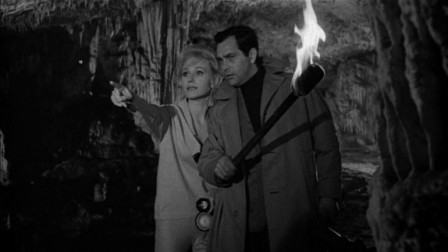
When he arrives at the inn, the innkeeper tells him that the maid, Maria (Erika Remberg), has already gone to bed for the night. Early the next morning, the police burst into Dorin’s room: Maria, who sleeps in the next room, is dead — and because he’s just arrived in the village, Dorin is a suspect. Dorin shows his police identification and takes charge of the local police force. The local doctor (Carl Mohner) declares that Maria simply died of heart failure, just like all the others. Dorin is incredulous. Heart failure in a young healthy woman for the seventh time in a row? Dorin points out two red puncture marks on her neck: what about those? But the doctor insists they’re superficial marks and couldn’t have contributed to her death.
The inkeeper is beside himself, telling Dorin that the previous night, he’d broken the chain on Maria’s crucifix, and had she been wearing it she would have been protected from the vampires that undoubtedly killed her. Dorin doesn’t believe in vampires, but clearly someone crept into her room and murdered her.
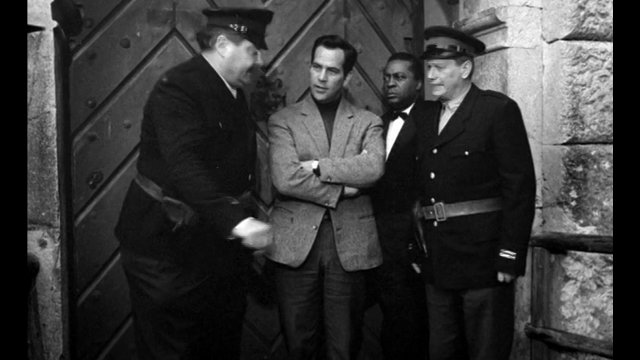
Seemingly everyone in town believes in vampires, except for the town’s doctor and Karin, who isn’t a local. But the villagers are a little scared of Professor van Adelsberg, whom they believe is tied up in the dark arts, as well as his servant John (both an outsider and black, though he appears to be more frightened of vampires than they are).
Both Dorin and the doctor are baffled when Maria’s body disappears from its room at the mortuary. The next morning, Dorin learns that Maria’s body has been found in the bottom of well. She was discovered there when a passerby saw torn fabric from her black dress clinging to the well’s edge.
To Dorin, this doesn’t make a lot of sense — especially since Maria was wearing a white dress when her body disappeared….
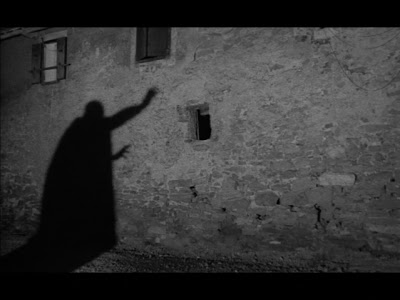
Comments: This interesting West German vampire movie was released in its native country in 1964 as The Curse of the Green Eyes, and in the UK as Cave of the Living Dead. It didn’t make it over the the U.S. until 1966, under the title Night of the Vampires. It appears to have been dumped on the drive-in circuit (on a double bill with the Italian Tomb of Torture) and it went to television shortly thereafter, where the title toggled back to the one used in Britain — Cave of the Living Dead.
It’s not a bad title, but modern commenters seem baffled that it isn’t a zombie movie — proving that the influence of George Romero’s Night of the Living Dead extends even to forever coloring the phrase “living dead”, once a fairly generic horror movie phrase for undead creatures of all stripes.
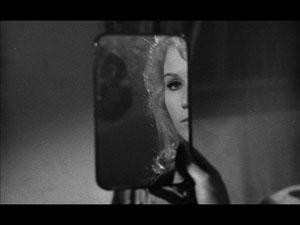
The movie is surprisingly light-hearted at times, not unlike the tone of Rialto’s krimi films of the era, but it also manages to be fairly atmospheric, making good use of the dark streets and its small-town setting. And it invents some intriguing bits of vampire lore of its own — for example, a vampire attack always causes a localized power outage, which effects not only homes and businesses, but automobiles and flashlights as well.
As a whole it’s enjoyable enough, though I had a couple of minor quibbles. The first is the character of Karin, quite aloof and independent through most of the picture, who suddenly melts into Dorin’s arms when he rescues her from the cave she’s gotten trapped in. She spends the rest of the movie traipsing around after him as his adoring girlfriend. It’s a bit jarring, seeing how sturdy and capable she was earlier in the film. It’s understood that in this sort of movie she is going to end up paired with Dorin, but they could have worked a little harder to make it plausible.
The movie is also a bit too straightforward and predictable. A couple of red herrings are thrown around in a half-hearted attempt at misdirection, but as it turns out the person we thought was the lead vampire is the lead vampire; we know how he will be dispatched and when. So there’s not a lot of suspense to be had.
Don’t let that stop you, though. It’s an agreeable little movie and if you get a chance to see it, you should definitely give it a chance.
Synopsis: Dr. Tim Mason (Roger Pryor) is conducting ground-breaking research in cryogenics. In a public demonstration, he lowers the body temperature of a patient until she is in a coma-like state. Five days later he brings her out of it, and after the procedure her chronic pain has diminished considerably.
After the demonstration, Dr. Mason tells his fiancee, nurse Judith Blair (Jo Ann Sayers) that his results are encouraging, but not what he had hoped. He reveals that most of his experiments are derived from the work of a mysterious Dr. Leon Kravaal (Boris Karloff), whose book on the subject of cryogenics hinted that he was in possession of a mysterious process that allowed the body to be completely frozen. Laboratory animals exposed to this process would completely recover from the freezing. Moreover, cancer cells in test animals disappeared after prolonged treatment, because the body’s immune system was still working while the cancer cells were suspended. Mason is fascinated by these revelations, and would love to get more of the details of the procedures from Kravaal; but the scientist vanished ten years earlier.
The hospital administration disapproves of all the meddlesome publicity that Mason is generating and they force him to take a leave of absence. Seeing an opportunity to track Kravaal down, Mason and Blair drive up north to Kravaal’s last known address. This turns out to be a spooky old house on a small island. The place had been abandoned since the disappearance of Kravaal, the county sheriff, county prosecutor, town doctor and two other townspeople.
Exploring the house, Dr. Mason and Judith discover a passage from the basement that leads to an abandoned laboratory, and beyond that, an icy underground cavern. In this cavern Dr. Kravaal is discovered. Using the specialized techniques he’s developed to revive hypothermic patients (i.e., warming them with blankets and pouring hot coffee down their throats) Dr. Mason eventually revives Kravaal. He’s astonished to find that he has been in suspended animation for ten years. Then he reveals that in a second chamber, behind the first, there are four bodies.
In a flashback sequence, Kravaal explains that the elderly Jasper Adams had come to him in hopes that frozen therapy might cure his cancer. Adams’ nephew became suspicious, and the county prosecutor brought Kravaal in. In the prosecutor’s office the town doctor avers that he had previously examined Adams, and it was clear the man’s cancer was terminal. Kravaal scoffs at the doctor’s hidebound pronouncements, but under duress he agrees to take the men to see Jasper Adams during his treatment.
Kravaal takes them, along with the county sheriff, to the island and the underground cavern. Seeing Adams’ frozen body, the doctor declares him dead, and the sheriff places him under arrest. Kravaal uses a beaker of chemicals to render his captors unconscious, but in the process places everyone — including himself — in a state of suspended animation.
After relating this amazing story, Mason and Judith help Kravaal revive the others, all of whom are astonished that ten years have passed and that they have all probably been declared dead.
When Jasper Adams’ loud-mouthed nephew destroys the formula used to put them in suspended animation, Kravaal kills him. He then tells the others that he must now reconstruct the formula, and he must use them all as his guinea pigs….
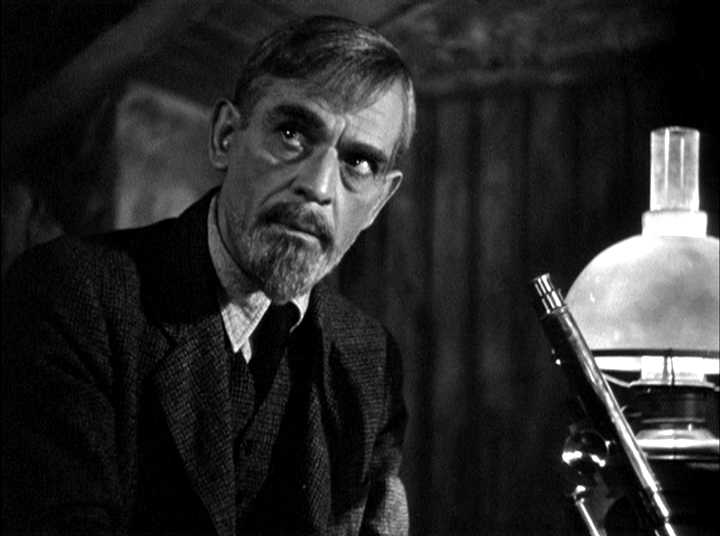
Comments: I’ve written about this film a few times before (it was an early Horror Incorporated staple) but I’ve never much cared for it (have I made a secret of that? I don’t believe I have). Even more than the other three mad scientist pictures Karloff did for Columbia, this one feels rushed and cobbled-together. Even though Boris gets top billing, Roger Pryor is the actual lead, and he’s simply too weak a presence to carry the movie as far as he needs to. All the plot contrivances necessary to get him and his bony girlfriend Judith to Kravaal’s island are a little hard to swallow, and lead to so many questions (why is the hospital so unhappy with the publicity Dr. Mason’s groundbreaking cancer research has yielded? Wouldn’t Kravaal have been declared legally dead and his estate liquidated years before? Wouldn’t the police have made a more thorough search of the Kravaal house if that many people were missing?, etc) that they end up sinking the movie.
But look, the only reason anyone’s watching is that Boris Karloff is going to appear. It doesn’t happen soon enough. But when it does, Boris doesn’t disappoint. He is not just sinister — lots of actors could do sinister — but also compelling, strangely likable, and almost sympathetic. We would never buy that Bela Lugosi or George Zucco was interested in the welfare of mankind, but we believe it when Boris says it, and we believe it even when he’s using his captors as guinea pigs in his experiments. Misguided, sure. Unethical, absolutely. But contemptuous of the human race? I dunno. Let me get back to you on that.
Karloff’s greatest enemies, though, are the ramshackle script and a lackluster supporting cast. The initial set-up of the movie – Mason and Judith setting out to find the mysterious Dr. Kravaal who disappeared a decade earlier – is intriguing, but the mystery is squandered by a whole host of increasingly absurd plot contrivances.
You’re probably best off approaching this one just as audiences in 1940 did – as a small programmer that might have occupied the bottom half of a double bill, with no ambition beyond killing 70 minutes. In the days before TV, that was enough.
But then again, in the days of Horror Incorporated, that was enough too, wasn’t it?


![Man With Nine Lives-CG.avi_snapshot_00.01.57_[2016.04.30_07.12.58]](https://horrorincorporatedproject.wordpress.com/wp-content/uploads/2018/06/man-with-nine-lives-cg-avi_snapshot_00-01-57_2016-04-30_07-12-58.jpg?w=723)
CAVE OF THE LIVING DEAD is one that sneaked by me ages ago, while THE MAN WITH NINE LIVES appears to be the one Columbia for Boris that has received the least amount of praise (he doesn’t show up until the 16 minute mark). I like the three that Nick Grinde made more than THE DEVIL COMMANDS or THE BOOGIE MAN WILL GET YOU, all of course included in SON OF SHOCK.
LikeLike
[…] up in Egyptian garb, given a scientific spin, turned inside-out, transplanted to the Old West, or 20th-century Germany, or 20th-century America, or done as a police […]
LikeLike
[…] up in Egyptian garb, given a scientific spin, turned inside-out, transplanted to the Old West, or 20th-century Germany, or 20th-century America, or done as a police […]
LikeLike